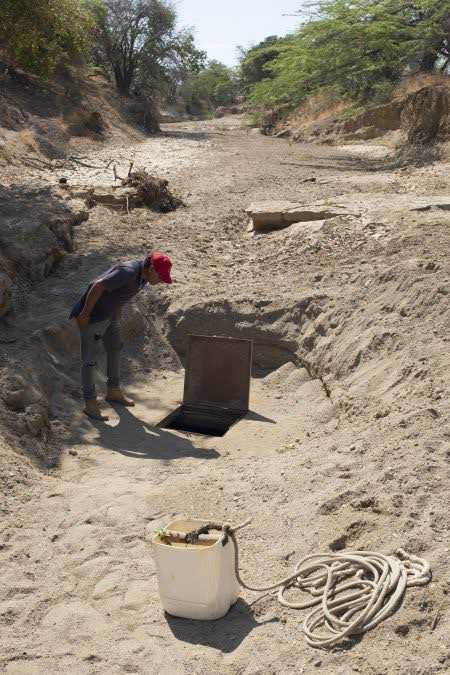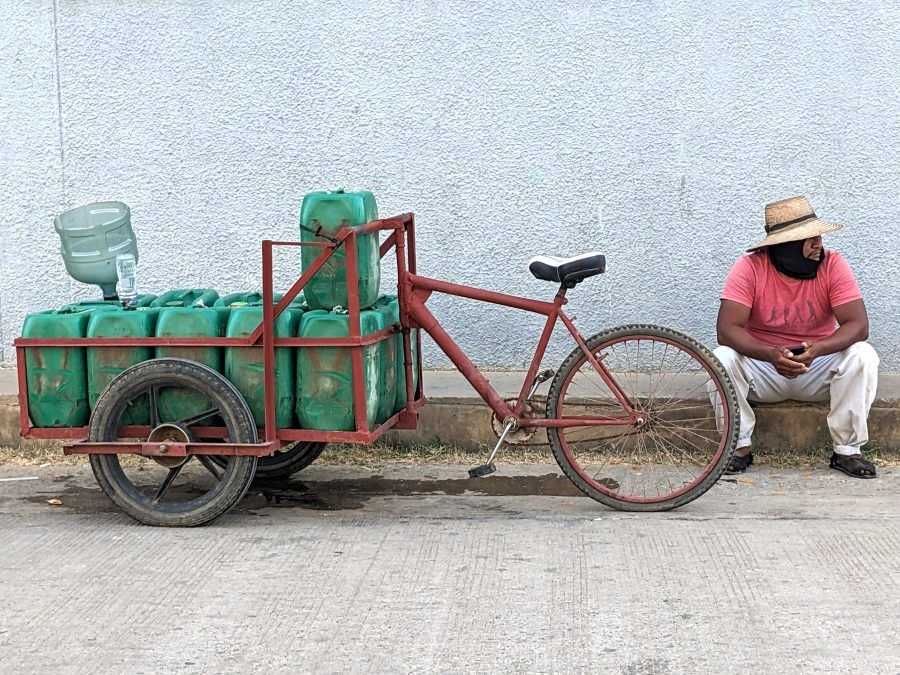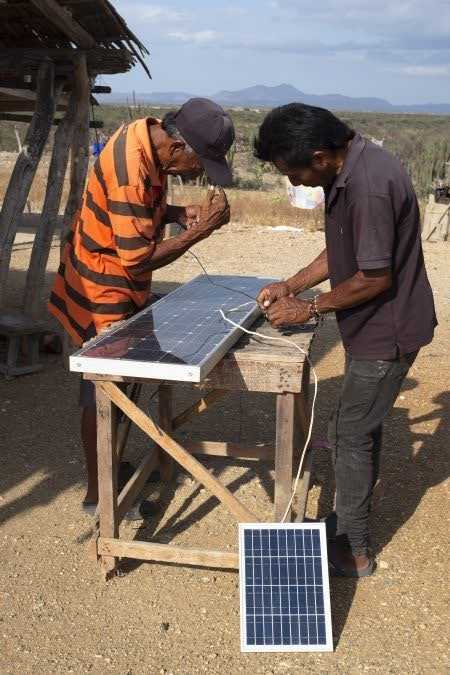Colombian president Gustavo Petro has just declared a one-month economic, social, and environmental emergency in the country’s La Guajira region. By declaring the situation an emergency, President Petro, who spent one week in the region in order to expedite the paperwork and ensure the implementation of the emergency measures, was able to pass laws that include sorely needed investments in education, health, tourism, and the water supply in the region.
La Guajira is a vast desert region in the extreme northeast of Colombia. It’s one of the main sources of energy in Colombia, home to a multibillion dollar coal mining industry and a prime spot for new wind farms. La Guajira is also home to the largest indigenous reservation in the country, the Wayúu reservation.
For too long, the Colombian government has cleared the way for huge national and multinational energy companies to extract resources from the region without distributing anything to the Wayúu, who have faced severe neglect. A new initiative by President Petro aims to rectify that, devoting resources to the development of renewable energy in a way that more equitably redistributes wealth to the indigenous people who live on the land.
Plundering La Guajira
Representing a fifth of the country’s indigenous population, Wayúu communities are spread out throughout the desert, with small clusters of homes known as rancherias representing different families and clans. The Wayúu are among the most marginalized of all communities in Colombia, and lack access to most basic services. About one-third of the Wayúu population live in poverty (with one-quarter in extreme poverty), while more than one in four Wayúu children under five suffer from malnutrition, with an infant dying every week in La Guajira.
La Guajira is the driest part of Colombia. The rainy season in La Guajira lasts only from September to October, barely enough to grow corn but in no way enough to meet the needs of the local communities in terms of drinking water. Apart from rudimentary rain collection devices, the only source for water for the communities deep in the heart of La Guajira Desert are wells. In many communities, water wells are basically just holes in the ground, some located beneath dried-out riverbeds. Problems of scarcity and salinization are common, and people must transport water to their homes often over great distances, the only mechanized transport within the desert being motorcycles.

Water is the most precious substance in La Guajira, and the scarcest. When water within the region becomes scarce, private water treatment plants in the towns and cities on the edge of the desert service the surrounding Wayúu communities. This treated water is expensive, and not all communities can afford to buy water or pay for its transportation. The trucks used to transport water from the cities to the communities located along the highway that stretches from the southern part of La Guajira all the way to the coast in the north, however, cannot enter deep into the desert communities as there are no adequate roads, and so these communities must survive on their own.
A lack of clean drinking water from underground water sources, due to increased temperatures and climate change, could in the future create a severe humanitarian crisis and drive whole communities from their ancestral lands (a lack of water has long been a major cause for displacement to urban centers). With projects designed to create and conserve water supply and delivery within the region for the use by indigenous communities, President Petro’s Pact for a Fair Energy Transition will be the first time in Colombian history that water for human consumption has been given priority over that used for crop irrigation or mining.
Since the Spanish conquest, Europeans and others have made fortunes extracting precious metals and minerals from La Guajira, all while local indigenous communities wallow in poverty. This long history of extractivism has generated extremely uneven development within the region, in which two radically different worlds coexist. In La Guajira, a single mine, El Cerrejón, has generated billions of dollars extracting and exporting coal for multinational corporations for decades while locals have had to subsist with the bare minimum of resources scraped from the surface of the desert.
Besides a few handouts, the local community receives little benefits from the Cerrejón coal mine, one of the largest open-air coal mines in the world, owned and operated by one of the world’s largest global resource companies. The Cerrejón mine was initially majority-owned and operated by ExxonMobil, which sold off its shares to Glencore in 2002 for a reported $600 million. Digging for coal at the Cerrejón began in 1984 (one million tons were shipped out that year) and is currently exporting thirty-two million tons annually.
The Cerrejón employs three thousand full-time workers, almost none from the Wayúu community. The company is equipped with a giant fleet of ground transport, including 250 giant trucks, many of which can transport 350 tons of coal each, and has its own private airport and landing strip.
It owns a private electric train of more than one hundred cars that transports coal almost one hundred miles between the Cerrejón mine in Lower Guajira to Puerto Bolivar, a private, gated port located on the north coast and from which the coal is shipped to the Europe (Colombia is Germany’s biggest supplier), Asia, and the United States.

The Cerrejón is the largest landowner in La Guajira, with giant parcels located throughout Wayúu territory. To build the Cerrejón coal mines, the port city, and the highway and railway that connect the two, hundreds of Wayúu families were run off their land, with the previous governments in Colombia legalizing these land grabs for the company.
To construct and operate the coal mines, more than fifty bodies of water, including the mighty Ranchería River, have either been diverted for their natural course by dams, appropriated for the sole use of the coal company, or destroyed by contamination. In large part, it is this theft and destruction of these water sources by the Cerrejón coal mine that has directly sunk the Wayúu communities in La Guajira into poverty and made life there so precarious, especially for infants, who suffer from the highest mortality rates in the country.
Not only has the Cerrejón mining company stolen tribal land and water, but it has also robbed the Wayúu communities of much of their view of the universe. The night sky in the La Guajira Desert is usually filled with stars, except to the northwest where the harsh lights coming from the mining company’s port city of Puerto Bolivar opaque whole constellations and replace the North Star with an artificial source of light, used to navigate within the dark desert.
The coal-supply railway lines divide La Guajira Desert from the coast, thus disrupting animal hunting paths and migrations. After long protests, the Wayúu community finally received compensation from the coal company for goats, horses, and human beings that were killed by the company’s nearly silent trains or giant trucks on the highway, but the communities’ grievances run much deeper than that.
Fighting Back
In June 2020, the Wayúu community requested the United Nations special rapporteur for human rights and the environment to investigate the Cerrejón mine for environmental and human rights violations. In September 2020, several UN independent human rights experts called for all mining operations to be halted, citing the serious damage to the environment and the negative effects on the health and other rights of the indigenous peoples who live in the area, but nothing was done about it by the Colombian authorities.
For centuries, the local indigenous communities have had little or no say in matters that affect their livelihood and survival. Since the government first issued a license to the Cerrejón in 1976, the company has negotiated and dealt in all legal matters directly with the Colombian government, without any input from or benefits to the Wayúu, a situation that has led to widespread corruption and conflict within the communities.

Colombia’s shift to renewable energies is an opportunity to break with the region’s long history of extraction, exploitation, and corruption of the coal mining industry. In all of South America, La Guajira Desert is the best site for wind-generated energy, with a constant nine meters per second at a height of eighty meters, and the potential to generate eighteen gigawatts of electricity (the rest of the country supplies thirty gigawatts), which has converted the region into a hot spot for green energy industries. Yet the green electricity generated within the indigenous reservation of La Guajira over the past few years hasn’t trickled down to the local communities.
More than 96 percent of Colombia is connected to electricity, but in the rural regions of La Guajira where most of the wind turbines are located, less than 5 percent is connected. Although wind turbines are much less environmentally abusive than traditional sources of energy, the giant wind turbines have been killing off birds and bats, affecting the ecosystem of the region. Green energy industries owned by European or American corporations, despite what they might say, are still extractive, concerned only with the profits they can extract from the region and usually unwilling to share the wealth, hire, or negotiate with local indigenous communities, which is why protests over the years by the Wayúu have shut down the turbines of several wind-energy companies.
To rectify this situation, President Petro has created the Pact for a Fair Energy Transition, a move away from coal and other extractive minerals toward renewable energy that benefits the local communities. The pact is the outcome of negotiations between the government, twelve private energy companies, and the leaders of over two hundred Wayúu communities. It will create almost one hundred new renewable energy projects, including fifty-three wind-generated and eleven solar-power parks. It will also install fifty miles of cables to distribute energy throughout La Guajira. In addition, the government will provide solar panels and batteries for the communities. As part of President Petro’s pact, all licenses issued to these and other companies will be subject to scrutiny by the Wayúu communities, who will have a say and will obtain a share of the financial benefits from the generation of energy in their desert.
The government’s promotion of renewable energy and its commitment to prioritizing the use of the region’s water supply for human consumption are both aimed at diminishing the damages of coal mining in the region. If President Petro’s pact is successful, a historical wrong will have been righted, and local indigenous communities will finally have a chance to enjoy the wealth and well-being provided by their own territory.
Kurt Hollander is a writer, photographer, and author of Several Ways to Die in Mexico City.
Photo: Citizens take part in a demonstration in support of President Gustavo Petro and the measures implemented in La Guajira on June 29, 2023, in Riohacha, Colombia. (Adri Salido / Getty Images)

